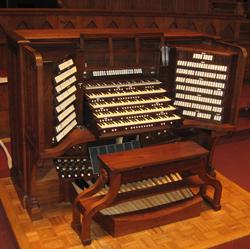
The Auditorium Organ in Ocean Grove, New Jersey, has recently undergone extensive tonal and mechanical renovations, highlighting its expansive symphonic and orchestral capabilities. This work, under the supervision of John Shaw, curator, and Gordon Turk, organist, has been accomplished by the team of Larry Trupiano, Bynum Petty, Sam Hughes, Bard Wickkiser, Carl Loser, and Bruce Courter. The organ is the centerpiece of the summer musical program in this historic 6,500-seat hall, and this year will mark the 110th summer season of organ recitals. The instrument has five manuals with 202 ranks.
Free recitals are presented by resident organist Gordon Turk and guest organists on Wednesdays at 7:30 p.m., and Saturdays at noon, during July and August. Guest organists for Wednesday concerts this season include: July 4, Michael Stairs; 7/18, Greg Zelek; 7/25, Carol Williams; August 15, Adam Pajan.
On Thursday, August 2, 7:30 p.m., the MidAtlantic Opera Orchestra, Jason Tramm, conductor, will join Gordon Turk for a performance of two organ concertos, the Concerto in A Minor by Enrico Bossi, and Symphony No. 1 by Alexandre Guilmant. This concert is part of the Summer Stars Chamber Music Festival.
For information: www.oceangrove.org.



